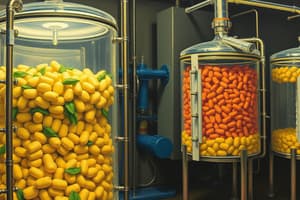Podcast
Questions and Answers
What is the primary function of a bioreactor in cell suspension culture?
What is the primary function of a bioreactor in cell suspension culture?
- To replace culture media at all times
- To permanently eliminate live cells
- To increase the number of cell walls
- To monitor and control environmental conditions (correct)
Which of the following features is NOT typically found in a bioreactor?
Which of the following features is NOT typically found in a bioreactor?
- A mechanism to sterilize the culture
- A built-in plant growth chamber (correct)
- Adjustable air supply
- Probes to monitor dissolved oxygen
Which application of bioreactors contributes to the production of foreign recombinant proteins?
Which application of bioreactors contributes to the production of foreign recombinant proteins?
- Direct soil cultivation
- Cell culture for hybrid plants
- Protoplast fusion
- Cell suspension culture (correct)
In bioreactors, which parameter is typically NOT monitored?
In bioreactors, which parameter is typically NOT monitored?
What is an important benefit of using bioreactors for the production of secondary metabolites?
What is an important benefit of using bioreactors for the production of secondary metabolites?
How do bioreactors maintain the aseptic nature of cell cultures?
How do bioreactors maintain the aseptic nature of cell cultures?
Which statement regarding bioreactors is accurate?
Which statement regarding bioreactors is accurate?
What is an advantage of using bioreactors compared to traditional fermentation methods?
What is an advantage of using bioreactors compared to traditional fermentation methods?
Which type of callus is characterized by loosely associated cells and easily breaks apart?
Which type of callus is characterized by loosely associated cells and easily breaks apart?
What is the primary difference between embryogenic and non-embryogenic callus?
What is the primary difference between embryogenic and non-embryogenic callus?
During which stage of callus culture does rapid cell division occur?
During which stage of callus culture does rapid cell division occur?
What process leads to the differentiation and formation of organized structures in callus culture?
What process leads to the differentiation and formation of organized structures in callus culture?
What is the main benefit of using a cell suspension culture over a callus culture?
What is the main benefit of using a cell suspension culture over a callus culture?
Which phase of a cell suspension culture is characterized by the highest rate of cell division?
Which phase of a cell suspension culture is characterized by the highest rate of cell division?
What is the purpose of adding pectinase to cell suspension cultures?
What is the purpose of adding pectinase to cell suspension cultures?
What happens during the stationary phase of a cell suspension culture?
What happens during the stationary phase of a cell suspension culture?
What is one primary advantage of using bioreactors in somatic embryogenesis?
What is one primary advantage of using bioreactors in somatic embryogenesis?
Which of the following best describes a characteristic of somatic embryos compared to zygotic embryos?
Which of the following best describes a characteristic of somatic embryos compared to zygotic embryos?
What is the main purpose of callus culture in plant tissue propagation?
What is the main purpose of callus culture in plant tissue propagation?
Which feature distinguishes organogenesis from somatic embryogenesis?
Which feature distinguishes organogenesis from somatic embryogenesis?
What factor is critical for the successful production of callus culture?
What factor is critical for the successful production of callus culture?
Which statement is true regarding the storage of somatic embryos?
Which statement is true regarding the storage of somatic embryos?
Which type of plant tissue is primarily used to initiate somatic embryogenesis?
Which type of plant tissue is primarily used to initiate somatic embryogenesis?
In the context of plant tissue culture, what is a characteristic of friable callus compared to compact callus?
In the context of plant tissue culture, what is a characteristic of friable callus compared to compact callus?
Flashcards
Death Phase in Cell Culture
Death Phase in Cell Culture
The stage of cell culture where the number of live cells decreases due to factors like nutrient depletion and accumulation of waste products.
Bioreactor
Bioreactor
A closed system designed for large-scale cultivation of cells, tissues, or organs. It provides a controlled environment for cell growth and production.
Protoplasts
Protoplasts
Plant cells that have had their cell walls removed enzymatically using cellulases and pectinases.
Protoplast Fusion
Protoplast Fusion
Signup and view all the flashcards
Haploid
Haploid
Signup and view all the flashcards
Androgenesis
Androgenesis
Signup and view all the flashcards
Gynogenesis
Gynogenesis
Signup and view all the flashcards
Anther Culture (Haploid Culture)
Anther Culture (Haploid Culture)
Signup and view all the flashcards
Compact Callus
Compact Callus
Signup and view all the flashcards
Friable Callus
Friable Callus
Signup and view all the flashcards
Embryogenic Callus
Embryogenic Callus
Signup and view all the flashcards
Callus Induction
Callus Induction
Signup and view all the flashcards
Proliferative Stage
Proliferative Stage
Signup and view all the flashcards
Morphogenesis Stage
Morphogenesis Stage
Signup and view all the flashcards
Cell Suspension Culture
Cell Suspension Culture
Signup and view all the flashcards
Habituation in Callus Culture
Habituation in Callus Culture
Signup and view all the flashcards
Organogenesis (Morphogenesis)
Organogenesis (Morphogenesis)
Signup and view all the flashcards
Adventitious shoots/roots
Adventitious shoots/roots
Signup and view all the flashcards
Somatic Embryogenesis
Somatic Embryogenesis
Signup and view all the flashcards
Somatic Embryos
Somatic Embryos
Signup and view all the flashcards
Callus Culture
Callus Culture
Signup and view all the flashcards
Dedifferentiation
Dedifferentiation
Signup and view all the flashcards
Differentiation
Differentiation
Signup and view all the flashcards
Study Notes
Plant Tissue Culture Application
- Plant tissue culture is used to apply various techniques for plant propagation, genetic improvement, and conservation.
- Different applications, including suspension culture, somatic embryogenesis, organogenesis, haploid production, short-term and long-term germplasm conservation, and somaclonal variations are discussed.
Organogenesis
- Organogenesis, or morphogenesis, is the production of new organs not present in the initial explant.
- Tissues or organs with the capacity for this are called morphogenic or organogenic.
- Adventitious shoots/roots are new organs induced to form on cultured plant tissues.
Somatic Embryogenesis
- Somatic embryogenesis is the process where somatic cells differentiate into embryos.
- Embryos formed by somatic cells are called somatic embryos.
- Somatic embryos can arise directly from explants or indirectly after callusing.
- Somatic embryos resemble zygotic embryos morphologically, are bipolar, and contain typical embryonic organs.
- They are not connected to explant or callus cells by vascular tissue.
- Somatic embryogenesis supports large-scale vegetative propagation and long-term storage of material via cryopreservation.
Callus Culture
- Callus is a mass of unspecialized, unorganized cells produced when explants are cultured on a solid medium supplemented with auxin and cytokinin.
- Callus is useful in producing variations among plantlets.
- Callus cultures may be compact or friable (compact shows densely aggregated cells, friable loosely associated).
- Embryogenic callus leads to plantlet regeneration via organogenesis or embryogenesis.
- Different types of callus exist (embryogenic and non-embryogenic).
- Callus culture involves three stages: induction (cell division), proliferative (rapid cell division), and morphogenesis (differentiation into organized structures).
Cell Suspension Culture
- Friable callus isolated from explants is grown in liquid media for cell suspension culture.
- Agitation (30-100 rpm) is necessary for suspension cultures.
- Suspension cultures grow faster than callus cultures.
- The medium often contains auxin, and pectinase can be added to improve single cell production and growth rate.
- The process of initiation and maintenance of plant cell suspension culture is explained by a diagram.
Haploid Production (Methods)
- Haploid cells have a single set of chromosomes, in contrast to diploid cells (2n).
- Haploid plants are vital for creating homozygous lines and for using plants in breeding programs.
- Methods of haploid production include androgenesis, gynogenesis, distant hybridization, and irradiation effects and chemical treatments.
- Androgenesis uses anther or pollen culture, while gynogenesis uses unfertilized ovules or ovaries.
- In vitro methods for haploid production include androgenesis and gynogenesis.
Comparisons of Anther and Pollen Cultures
- Anther culture is easy, quick and practicable but can have unwanted diploid/aneuploid variation within the plant population from anther sources.
- Pollen culture can overcome these problems.
Gynogenesis
- Gynogenesis is the culture of unfertilized female gametophytes (ovules or ovaries).
- Used when plants don't respond to androgenic methods or when producing albino plants is a problem.
- Gynogenesis is less efficient than androgenesis in some plant families (e.g. Liliaceae, Compositae).
Germplasm Conservation
- Germplasm conservation seeks to preserve genetic diversity of a specific plant or genetic stock.
- Conservation methods include in situ (in the natural habitat) and ex situ (gene banks, seed banks).
- In vitro germplasm conservation methods explained include cryopreservation, cold storage, and low-pressure/low-oxygen storage.
- Protocols for cryopreservation of shoot tips are outlined in a diagram.
Somaclonal Variation
- Somaclonal variation is genetic diversity among plants regenerated from somatic cells (in vitro).
- Although these plants should be clones, some observations show they’re not.
- Somaclonal variation is useful in various breeding programs for useful traits and breeding lines.
- Somaclonal variation can be useful in developing new crop varieties with novel variations.
- Advantages and disadvantages of somaclonal variation are highlighted.
Studying That Suits You
Use AI to generate personalized quizzes and flashcards to suit your learning preferences.




